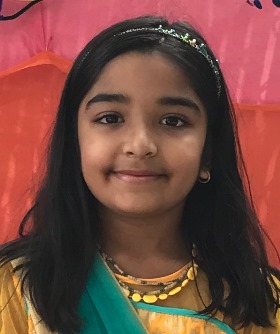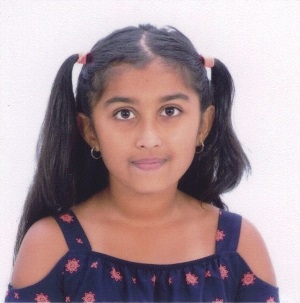CHILDREN’S FESTIVAL ESSAY WRITING CONTEST

(Left) Meher Sanghavi, age 7, the first place winner in Group A (ages 5-8 years).
Khabar's CHILDREN’S FESTIVAL ESSAY WRITING CONTEST:
Winning entries offer unique perspectives and memories of youngsters on Diwali, Eid, Halloween, Navaratri, and more.
Thanks to all those who participated in our first essay contest for children. We enjoyed reading the essays and were impressed by the dedication of the writers. As our judge noted, it was really hard to choose the winners. It’s worth pointing out that a writer’s job is to reflect and record—and that in itself is rewarding.
Congratulations! All the winners below will receive cash prizes.
Group A (5 to 8 years)
First Place: MEHER SANGHAVI (“My Special Diwali”), Marietta, GA
Second Place: NEHAA RAJAGOPA (“I Love Diwali!”), Marietta, GA
Honorable Mention: RIYA KOTHARI (“Diwali with My Grandparents”), Grayson, GA
Group B (9 to 14 years)
First Place: AMINAH MUHAMMAD (“My Eid”), Lawrenceville, GA
Second Place: ASHA AHN (“The Frankenstein Family”), Atlanta, GA
Honorable Mention: ANAND KRISHNAN (“Season of Navarathri”), Suwanee, GA
Honorable Mention: ARUSHI GUPTA (“Celebrating Diwali”), Cumming, GA
Anjali Enjeti, our judge this year, is an award-winning essayist who serves on the board of the National Book Critics Circle. Her work has appeared in The Atlanta Journal-Constitution, The Atlantic, The Week, NPR, The Guardian, The New York Times, and elsewhere.
She lives in Johns Creek, GA, with her family.
673.jpg)
673.jpg)
|
Festival Essay Contest, Group A, Honorable Mention
|
|
|
Diwali with my Grandparents
In America there are four seasons: spring, summer, fall, and winter. Of all the seasons, my favorite is the fall. Now, if you are thinking it’s because of pleasant weather, then nope! You are wrong.... Riya Kothari, 8, is a 3rd grader at Grayson Elementary School. |
673.jpg)
673.jpg)
|
Festival Essay Contest, Group B, Honorable Mention
|
|
|
‘Tis the season of Navarathri
Navarathri is the celebration of the victory of good over evil. It is nine nights long, because it took nine nights/days for Durga to defeat Mahishasur. South Indians usually set up seven or nine stairs and arrange dolls on them. These dolls are usually of gods and goddesses. This is called a golu. Most families have some sort of theme in their golu. This year, I went and saw an Ayappa theme, an Egyptian theme, and a wedding theme, and many more. Anand Krishnan, 11, is a 7th grader at North Gwinnett Middle School. |
|
Festival Essay Contest, Group B, Honorable Mention
|
|
|
Celebrating Diwali Lamps everywhere, colorful clothes, shining sequins, and delicious food. It may sound like I am describing Thanksgiving or Christmas, but it is actually Diwali, an Indian festival of lights. Celebrating this Indian holiday in America is fun because you learn more about your culture. Diwali celebrates the victory of good over evil. We celebrate Diwali by praying, also known as pooja in Hindi. We also eat traditional food and light fireworks in the company of friends and family. Celebrating Diwali in America helps me learn about my heritage, spend time with family, eat wonderful food, and wear traditional clothing. |
Enjoyed reading Khabar magazine? Subscribe to Khabar and get a full digital copy of this Indian-American community magazine.
blog comments powered by Disqus













